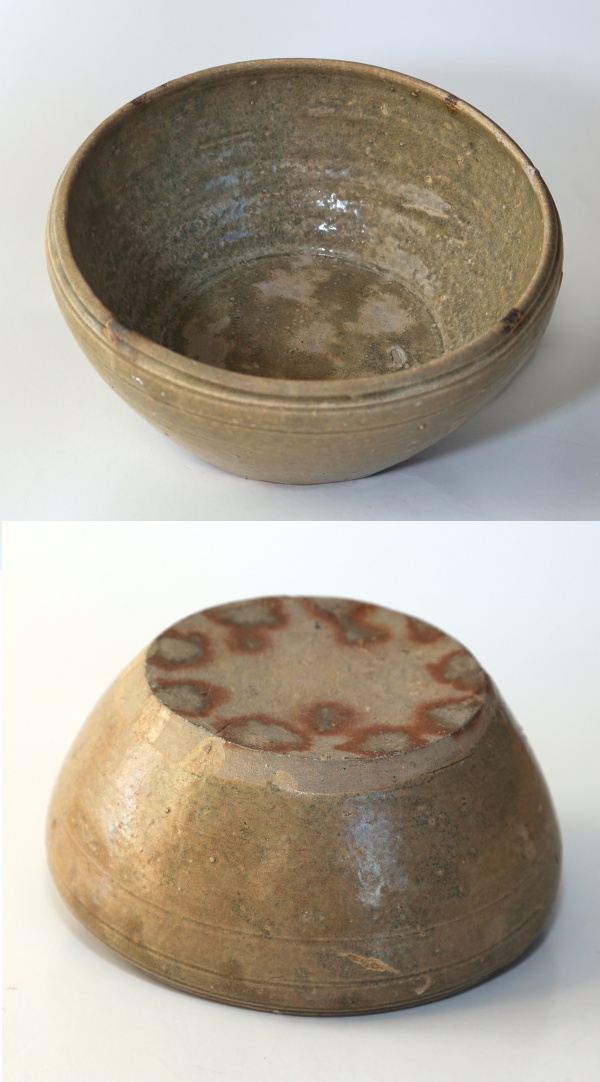
Greenware bowl, Yue kiln-sites, late 4th century - early 5th century AD. Western Jin Dynasty (AD 265 - 316) - Eastern Jin Dynasty (AD 317 - 420) - Six Dynasties Period (AD 221 - 589); stoneware, with green glaze; unglazed base; glazed rim; 8.5 cm (height), 19.5 cm (diam.).
Jan-Erik Nilsson Coll. 2017
From the Yue Kilns in Zhejiang Province located south of Hangzhou Bay, slightly south of present day Shanghai.
Chinese greenware produced in the ancient state of Yue, during the Eastern Zhou dynasty. Yue yao usually refers to Tang dynasty celadon colored stonewares from Zhejiang Province but Yue yao was made here from Eastern Han Dynasty in the the 2nd century, to Song Dynasty Period, at kilns initially concentrated to Shangyu, Yuyao, and Shasoxing in the north of Zhejiang province, the cultural and economic center for the Kuaiji prefecture of the Yue state before the Tang dynasty.
The number of kilns then grew during the Six Dynasties to around thirty. Among the products there are funerary objects connected to the southern rice culture, and storage jars, transported down the Cao'e River and exported by sea via Hangzhou Bay.
High-fired green-glazed ceramics were first made in east China more than 3,000 years ago. The earliest pieces imitated the shapes and decoration of bronze ritual vessels. Later wares were made for daily use and for burial in tombs. Many burial wares were ceramic models that showed aspects of daily life, such as cooking stoves or domestic animals. From about AD 300 onwards, the Yue kilns began producing ink stones and water droppers for calligraphers. In the Tang dynasty (AD 618-906) the wares were used for tea-drinking. They were much admired and praised by poets.
The term Yue yao refers to a group of early Chinese kilns famous for producing some of the first true celadon wares in Chinese history. These kilns were concentrated around Shanglin Lake, near present-day Cixi in eastern Zhejiang province, and flourished from the late Eastern Han dynasty (2nd–3rd century AD) through the Northern Song period (10th–11th century), a span of nearly a thousand years.
The Yue kilns are regarded as the origin of Chinese celadon, developing from simple green-glazed stonewares into highly refined pieces distinguished by thin, dense bodies, smooth translucent glazes, and delicate bluish-green tones. During the Tang dynasty (618–907), Yue wares achieved great prestige and were used as tribute ceramics for the imperial court. The finest examples, often referred to in historical records as “secret-color porcelain” (mi se ci 祕色瓷), were produced under official supervision at Shanglin Lake.
Common forms included bowls, dishes, censers, ewers, and ritual vessels, characterized by their restrained decoration, elegant proportions, and subtle aesthetic that influenced later celadon traditions, particularly those of the Longquan kilns.
The name “Yue” derives from the ancient Yue state, which once occupied this part of Zhejiang; the literary term remains in use today (as in Yue Opera). Archaeological excavations around Shanglin Lake, where more than 100 kiln sites have been identified, have revealed the full technological and artistic development of Yue ceramics.
In 1988, the Shanglin Lake Yue Kiln site was inscribed on the National List of Key Cultural Relics, recognizing its pivotal role in the evolution of Chinese porcelain and its lasting influence on ceramic art throughout East Asia.
A